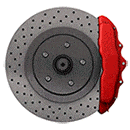“You’re going to need new brakes.”
Nobody wants to hear those words, even though they’re fairly common. As car parts and repairs go, replacing brake parts is one of the most regularly repeated maintenance procedures. After oil changes, brake changes are probably one of the most frequent car repairs.
But what exactly does it mean when you “need new brakes?” Better yet, is there a way to diagnose brake problems yourself? Let’s answer the first question, and then we’ll look at certain things to look for when your brakes start to go bad.
1. You hear a grinding sound.
A rumbling, deep grinding metal sound is an auditory sign it’s time for new brakes. Many brake pads come equipped with tiny metal ridges on the bottom of the pad to alert the driver that the pads have worn down. Once you notice the grinding sound, take the vehicle to an automotive professional sooner rather than later. Continuing to drive with brake pads in this condition could allow the brakes to rub metal to metal, damaging rotors and causing other costly repairs.
2. You hear squeaks or squealing.
It’s normal for some squeaking from time to time, especially in wet weather conditions or when a bit of brake dust gets between the pad and rotor. However, hearing a squeak or squeal every time you brake, could indicate it’s time to replace the brake pads.
3. Your brake pedal vibrates.
When you step on the brakes and it feels like the brake pedal is shaking beneath your foot, or feels unsteady as you press down, there’s a good chance your brake pads have worn down or the brake rotors have a problem and are in need of attention. Have your vehicle inspected right away.
4. The brake light turns on.
In many vehicles, a sensor on the brake pad monitors the level of wear and once it reaches a certain point, the sensor triggers the light on the dashboard to come on. If your brake light is illuminated, get your vehicle to a professional to have the brakes inspected as soon as possible.
5. Your vehicle pulls to one side.
A car that pulls to one side when braking could indicate that the brake pads are worn or there is a caliper problem. If these problems continue, the rotors can become warped. Pulling can also be caused from stress on the braking system including towing, mountainous terrain, or aggressive braking.
Should I Replace My Brake Pads and Rotors?
When it’s time to replace brake rotors, consider replacing the brake pads at the same time. Brake pads and rotors wear down together and the pads come in contact with the rotors at the same spot many times in one day. When you replace the rotors, you have a clean, flat surface while your brake pads still have their grooved areas from contact with the old rotors.
By placing the old pads with the new rotors, the brake pads will only come in contact with the rotor on its high points, as the grooved areas are unable to reach the rotors. When the pads are unable to come in contact with the rotors, it impedes the stopping power. In an emergency, you may not be able to stop in adequate time.
It’s important to take the time to really pay attention to your vehicle and how the brakes are functioning on a regular basis. By taking note of how they typically feel or operate, you’ll be able to easily notice changes in their performance—making it easier to determine when to service your brakes.
The best way to avoid costly, unnecessary brake repairs is to have your brakes inspected at each scheduled oil change. So if you have any concerns about your brakes, consult our team for brake recommendations to get you back on the road quickly.


